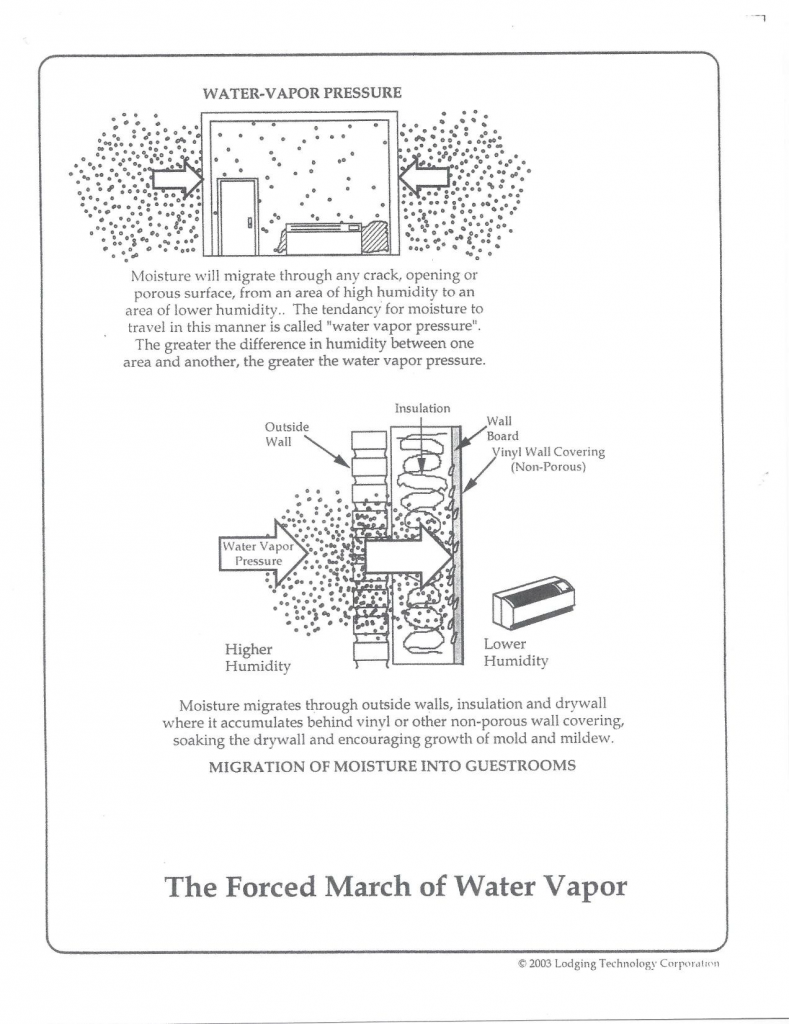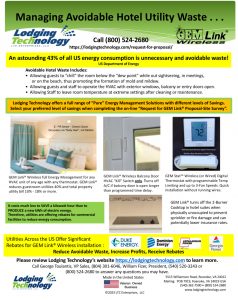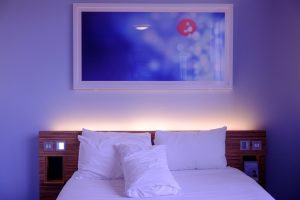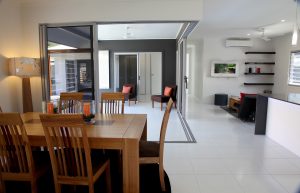About humidity, what is it exactly?
Humidity refers to the amount of water vapor (moisture) suspended in air. It is measured as Percent Relative Humidity (%RH) or the percentage of water vapor that can possibly be contained in air, at its present temperature. Air at 0%RH is completely dry and free of moisture; air at 100%RH contains all the moisture it can possibly hold at its present temperature and will be exhibited as condensation, fog or rain. The amount or volume of water vapor that can be contained in air varies with air temperature. Air at 50°F and 60%RH contains less moisture in suspension than air at 80°F and the same 60%RH. Warmer air can hold more moisture than colder air. Air at 90°F can hold twice the volume of moisture as air at 70°F.
But where does guestroom humidity come from?
In a word, guestroom humidity comes from OUTSIDE. Water vapor (moisture) will migrate from a moist area to a drier area, from an area of higher Relative Humidity (RH) to an area of lower RH. When a room is air conditioned and de- humidified, moisture will migrate from hot, humid outdoor air to cool, dryer indoor air. It will penetrate any crack, opening and porous or semi-porous material that has pores large enough for a water molecule to traverse. It is unrelenting in its ability to equalize the amount of water vapor from a moist area to a drier area. This ability to migrate is called “water vapor pressure.” The greater the difference in temperature and relative humidity between outdoors and an air conditioned indoor area, the greater the “water vapor pressure” and the tendency for moisture to move into the drier area.
Some humidity is generated inside the room from a guest’s breathing and showering, and a housekeeper cleaning. However, humidity levels from inside causes are small, compared to external migration and can easily be handled by the air conditioning unit. Guests are only in the room a short time. Un-rented rooms are empty 100 percent of the time, except for hotel staff. Even rented rooms are only occupied eight to 11 hours out of a 24-hour period.
Can moisture get into the room?
Water vapor can and will move through the building’s porous outside covering whether it is brick, paint, stucco or some other material. It moves through the wall cavity, insulation and drywall, until it is stopped by non-porous or semi-porous vinyl wall covering. Therein lays the problem. Moisture will collect behind cool vinyl wall covering where it condenses, soaks the drywall and insulation making it soft and crumbly, encouraging the growth of mold and mildew.
Moisture may also enter the room through open exterior doors, from unconditioned interior hallways, through air leaks around the HVAC damper or wall sleeve and through cracks around weather seals in windows and doors that are in poor condition. These leaks should be repaired to lessen the heat and moisture load on the HVAC unit. Moisture generated inside the room from people and showers may occasionally condense on cool vinyl wall surfaces if the HVAC load is too great at the time but will not penetrate through to the drywall. Moisture damage and the resultant growth of mold and mildew usually occurs in the corner of outside walls and at wall covering seams where moisture finds an easier path to migrate to drier inside air. The fact that water damage is behind the vinyl wall covering indicates that the moisture came from outside the room.
Mold and mildew are minute, living, parasitic organisms called fungi (this also includes rusts, smuts, mushrooms, toadstools and puff balls). They must have three essential elements for survival and growth: (1) correct temperature, (2) sufficient moisture and (3) food.
The climate provides the temperature and moisture while wall covering pastes, drywall and other construction materials provide food. Anti-microbial treatments may be applied to wall coverings to kill or retard mold and mildew growth. However, moisture damage will continue until outside air and moisture leaks are plugged, appropriate vapor barriers are installed or repaired, and air conditioners are sized and operated in a manner to reduce migration and increase the removal of internal moisture.
Don’t chill guestrooms below the dew point.
The “dew point” is the temperature at which air can no longer hold all the moisture it contains in suspension. Some water vapor must come out of suspension and condense in the form of water droplets.
When guestroom walls are allowed to chill below the dew point all day (when guests are out), moisture from inside and outside sources will condense on both sides of the wall covering, thus damaging drywall and encouraging the growth of mold and mildew. It also condenses and is absorbed by cool furniture and bedding surfaces and causes the room to feel cold and clammy, rather than cool and dry.
[Note: Guest education cards regarding the importance of maintaining temperature control will go a long way to making the guest feel more comfortable, especially the guest who is not used to warm, humid climates. Educating the housekeeping staff about the need to adjust room temperature levels as a general practice will help the hotelier save energy and remodeling costs, while helping to preserve clean indoor air.]
Envelope factors determine guestroom humidity levels.
Guestroom humidity levels are determined and controlled by the building envelope, the presence or absence of proper vapor barriers, clogged weep holes in exterior walls, liquid water or air leaks, type of internal wall covering and BTU (British Thermal Unit) rating of the HVAC unit compared to room size (bigger is not always better). In hot, humid climates buildings should be sealed with an appropriate vapor barrier on the outside to keep moisture out; in cold, dry climates the inside surface of the room should be sealed to retain moisture. It is important to ensure that HVAC BTU ratings are appropriate for the room’s size, type of construction and local climate. Coils and condensate drains must be properly maintained to transfer condensed moisture outside.
Florida’s humidity problem has been studied.
Guestroom humidity is a big issue in Florida, Texas, Louisiana and other hot, humid Southern states and has been extensively studied. Lodging Technology Corporation has participated in several “enviroroom” projects with the Florida Lodging Association, Florida Governor’s Energy Office and the University of Florida’s Energy Extension Service. The major source of humidity, moisture and mildew damage is infiltration of humid, outdoor air into the wall cavity and room. Florida guests don’t take more showers or otherwise generate more moisture from indoor sources than guests in other parts of the country. The Florida studies indicate that:
• Excess migration of external water vapor through the building structure and air and water leaks cause drywall damage and mold and mildew growth.
• Over-sizing of the HVAC unit uses more energy and causes the average relative humidity of the room to increase.
• In very humid climates, the indoor fan should be cycled off with the compressor to prevent blowing moisture from the coils back into the room during the compressor’s off time.
• Bathroom exhaust fans that remove too much air actually increase humidity levels by pulling more make-up air than is necessary from outside. The American
Society of Heating, Refrigerating & Air Conditioning Engineers (ASHRAE) recommends a minimum ventilation of 15 cubic feet per minute (CFM) per person or 30 CFM per guestroom. Tests indicated that some exhaust fans pull 70 to 90 CFM and were inconsistent from room to room on the same property.
• Sensor-based occupancy energy management systems have no negative effect on room humidity levels. Conversely, they do provide some reduction in average relative humidity.
• Some sensor systems which contain a “humidity sensor” claim large reductions in room humidity levels. Such claims are more marketing hype than fact. Guestroom HVAC units are temperature-operated (thermostat) devices. The air conditioning unit will only operate to its own thermostat setting, regardless of humidity. Sensor systems cannot force the HVAC unit to operate if it would not otherwise be operating according to its thermostat setting. Removing moisture is simply a secondary result of cooling room air.
Guestroom occupancy sensing systems have a positive effect on humidity control.
A properly designed occupancy sensing system does not turn off the heating/ cooling unit in unoccupied rooms. It maintains the room at a slightly warmer, management-selected, energy-conserving temperature. The system prevents chilling of the room during the hot and humid midday when guests are typically out, thus reducing water vapor pressure, migration of moisture into the room and condensation.
Warmer air “holds” more moisture, removing water from furniture, fixtures and equipment (FF&E). Remember that air at 90°F holds twice the volume of water as air at 70°F does. Energy management systems (EMS) assist in the reduction of humidity problems. The key is to install a sensing system that includes a temperature setback feature and operates the air conditioner periodically to lower room temperature and remove large amounts of moisture from the warmer air. The room is again allowed to warm up and “pull” more moisture from furnishings. This cycle is repeated while guests are out of the room 60 percent of the day.
General Electric (GE), Amana, Carrier and other HVAC manufacturers offer energy management interfaces on their units. GE was the first to provide this feature on certain models in 1972 and has the most extensive experience. All current GE and Amana PTAC (Packaged Terminal Air Conditioner) units for hotels have an EMS interface, designed for front desk or occupancy sensor control, as a standard feature.
Occupancy sensing systems will increase profits by reducing room HVAC energy consumption by 35 to 45 percent, while improving guest comfort and preserving guestroom FF&E. Hoteliers will clear the air of unwanted moisture while taking profits to the bank.



